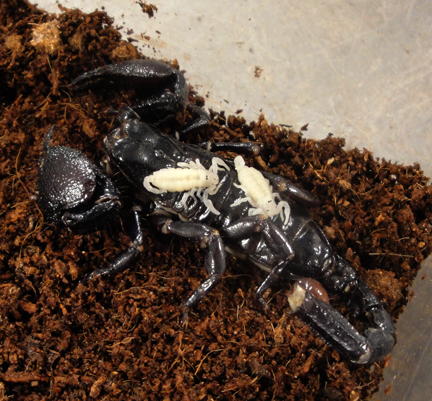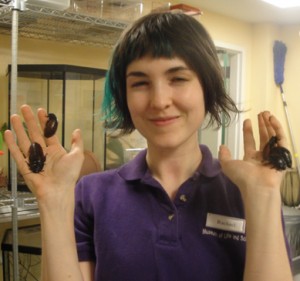We did have births at the Museum in April, although not wolf pups. Rachael Knight, the Museum’s entomology specialist, spends her time in the Insectarium. Read her report below about the birth of some Pandinus Imperator scorpions. Please let us know in the comment section if you’d like Rachael to share more stories from the world of invertebrates!
As far as we know there were three of them [scorplings]. When we (Butterfly House staff) noticed the little white chubby nymphs clinging to one of our Pandinus Imperator scorpions, we deduced that one of our new females must have arrived pregnant. Since then I’ve read varying statistics on the internet concerning Emperor breeding and care of “scorplings.” (A word I’d not encountered before and find quite delightful.)

Gestation, apparently, can last anywhere from seven to eighteen months, the number of young ranges from just one, all the way up to twenty, and by all accounts, a myriad of conditions need to be met, humidity being the most crucial. Considering that our enclosure is designed for viewing instead of rearing, and that so many variables were at play, I thought it best to remove mother and riders to a new location.
By the time I’d decided to do this, one of the scorplings was missing, eaten as far as we know. For, as I have learned, obligate burrower mothers, such as ours, are cannibalistic. She may eat her young, other scorpions may try to eat them, the food insects may eat them, and if they manage to survive through their first molt, they may eat each other. In spite of, or perhaps because of all this cannibalism, scorpion mothers are very protective of their young. They in turn, are reliant on her, even after they’ve begun to venture out on their own they will scurry back when frightened. I hope the little scorplings make it, because I’d really enjoying watching them grow. However, the guides and care sheets I’ve read so far have put my expectations fairly low. I’ll try not to feel too bad if they don’t, and keep in mind the dubious, yet reassuring stat: “As few as 1% survive to adulthood in the wild.”

Yes, yes, we want to hear more stories from the invertebrate world!
I agree, the word scorplings is rather delightful.
Is the survival rate for scorplings in the wild typically higher or lower than for captive bred scorplings?
Good post!!
I would love to hear more about invertebrates on the Animal Keeper blog!
Absolutely yes to more invertebrate stories! I’m loving the new word “scorplings” — I’m going to try to incorporate it into as many conversations as possible. Thanks for the inspiration!
Here’s hoping for that 1%, it would be awesome to see their development documented. Keep up the posts!
Wow, who knew scorpions could be cute?
Wow, being a scorpling is dangerous!
Yes, more stories about invertebrates would be super!
Definitely more invertebrate stories!!
Awesome blog. Informative and creative. A nice blend! Keep these blogs coming.
Very cool, I’d love to hear more too!
Wow, that’s awesome! And they are so cute! Are they just as venomous at that young age as the adults?
Yes, I would love to hear more stories from Rachel and the invert corner of the museum! It would be neat to document the development of these scorplings and other critters you guys have.
Yes – More Please!
I’d like to know how they’re doing now. My P. imperator just had wee scorplings!
And wow, Rachael is very lovely, especially holding cockroaches.
We’ll have an update soon Mike.
Post more updates about all the awesome bugs you have at the museum, Rachael! Personally I’m a big fan of beetles; the Atlas Beetle was my favorite.